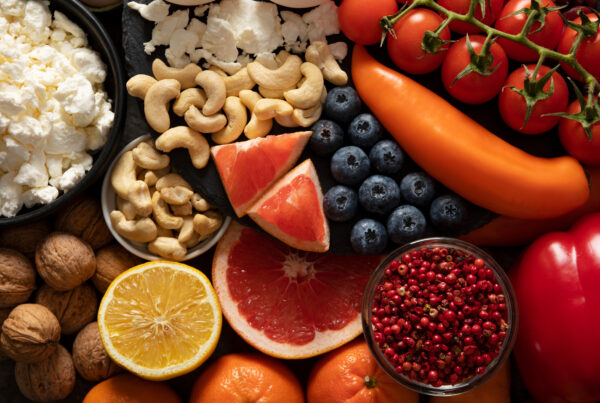1. Leafy Greens

Why Leafy Greens Are Essential for Weight Loss
Leafy greens like spinach, kale, and Swiss chard are low in calories but high in fiber, vitamins, and minerals. They add volume to your meals, helping you feel full without extra calories. Their high fiber content also promotes satiety and stable blood sugar levels, making them a must-have for weight loss.
2. Lean Proteins

How Lean Proteins Boost Satiety and Metabolism
Protein is essential for muscle maintenance and keeping you full longer. Foods like chicken breast, fish (especially fatty fish like salmon and tuna), and legumes (lentils, beans) are excellent sources. They not only help curb hunger but also support metabolism and fat burning.
3. Whole Grains

The Benefits of Whole Grains for Lasting Fullness
Whole grains are rich in fiber and complex carbohydrates, providing sustained energy and keeping you satisfied. Quinoa, brown rice, and oats are particularly beneficial, as they also supply protein and essential nutrients.
4. Nuts and Seeds

Healthy Fats and Fiber: The Power of Nuts and Seeds
Packed with healthy fats, fiber, and protein, nuts and seeds (like almonds, walnuts, and chia seeds) can help control cravings and support heart health. Enjoy them in moderation as a snack or add them to salads and yogurt for an extra nutrient boost.
5. Fruits

Natural Sweetness and Fiber from Fruits
Naturally sweet and low in calories, fruits such as berries, apples, and pears are rich in fiber, antioxidants, and vitamins. They help satisfy your sweet tooth while supporting digestion and overall health.
6. Cruciferous Vegetables

Cruciferous Veggies: Filling and Nutritious Choices
These vegetables are high in fiber and low in calories, making them incredibly filling. Cruciferous veggies also contain plant compounds that may boost metabolism and aid in fat loss.
7. Greek Yogurt

Protein and Probiotics: Why Greek Yogurt Stands Out
Greek yogurt is an excellent source of protein and probiotics, which support digestion and keep you full longer. Opt for unsweetened varieties and pair with fresh fruit for a healthy, satisfying snack.
8. Healthy Fats

The Role of Healthy Fats in Weight Management
Healthy fats from sources like avocado and olive oil are crucial for satiety and nutrient absorption. They support heart health and can help reduce inflammation, making them a smart addition to any weight loss plan.
How to Start Your Weight Loss Journey
- Set Realistic Goals: Begin with achievable targets, such as losing 1-2 kg per week.
- Track Your Progress: Use a journal or app to monitor food intake and physical activity.
- Prioritize Consistency: Small, daily improvements yield long-term results.
Choosing the Right Diet for Weight Loss
- Focus on Nutrient-Dense Foods: Fill your plate with vegetables, lean proteins, and whole grains.
- Limit Processed Foods: Reduce sugar, refined carbs, and high-fat snacks.
- Stay Hydrated: Drinking water before meals can help control appetite.
Weight Loss Diet Plan: What to Eat and Avoid
A structured weight loss diet plan enables you to stay on track. Consider:
- Caloric Deficit: Consume fewer calories than you burn.
- Meal Timing: Eat regular meals and avoid late-night snacking.
- Balanced Macronutrients: Ensure a mix of protein, healthy fats, and complex carbs.
Nutritionist Diksha Weight Loss Diet
A key part of Diksha’s weight loss success was the diet she followed. Instead of opting for extreme diets, she focused on balanced and nourishing meals that provided long-term benefits. Her morning started with a refreshing drink made of coriander seeds, celery seeds, and ginger water—an option she believes helped detoxify her body. If preferred, she also included jeera water.
For breakfast, Diksha consumed two whole eggs and a packet of mushrooms, which provided a good dose of protein to start the day. She also included moong dal chilla with vegetables and mint chutney as an occasional alternative. The mid-meal consisted of almond milk coffee or coconut water, which kept her energized without the need for unhealthy snacks. For lunch, Diksha often enjoyed a chicken and hummus salad or, as a vegetarian alternative, a chickpea and hummus salad.
Anti-Inflammatory Diet for Weight Loss
An anti-inflammatory diet for weight loss can reduce bloating and support overall health:
- Include: Leafy greens, berries, fatty fish (like salmon), nuts, and olive oil.
- Avoid: Processed meats, sugary drinks, and excessive dairy.
Diet Chart for Weight Loss for a Female in 1 Month
| Meal | Example Foods |
|---|---|
| Breakfast | Oats with berries, chia seeds, and almond milk |
| Mid-Morning | Apple or a handful of nuts |
| Lunch | Grilled chicken salad with mixed greens and olive oil |
| Snack | Greek yogurt or carrot sticks |
| Dinner | Steamed fish, quinoa, and steamed broccoli |
| Hydration | 8-10 glasses of water daily |
7-Day Diet Plan for Weight Loss
| Day | Sample Focus |
|---|---|
| Day 1 | High-protein breakfast, light dinner |
| Day 2 | Add more leafy greens |
| Day 3 | Include healthy fats (avocado, nuts) |
| Day 4 | Limit carbs after lunch |
| Day 5 | Focus on lean proteins |
| Day 6 | Hydrate and add fiber-rich foods |
| Day 7 | Balanced meals, avoid processed foods |





